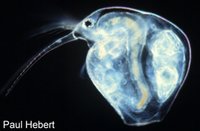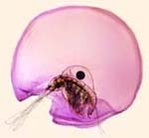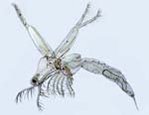
| Palaeos |  |
Branchiopoda |
| Arthropoda | Cladocera |
| Page Back | Unit Up: Arthropoda | Unit Home | Clade Up: Eucrustacea | Page Next |
| Unit Back: Labrophora | Clade Down: None | Dendrogram | References | Unit Next: Maxillopoda |
|
Abbreviated Dendrogram
CRUSTACEA |--Phosphatocopida `--+--BRANCHIOPODA | |--Anostraca | `--+--Notostraca | `--+--Conchostraca | `--+--Cladocera |?--Xenocarida `--+==Maxillopoda |--Ostracoda `--Malacostraca |
Contents
Overview |
Taxa on This Page
This content on this page copied verbatum from Encyclopedia of Earth - Crustacea under Creative Commons Attribution Share-Alike license. It is intended at some point to add additional material on evolution, paleontology, etc MAK120517
 (Source: Biodiversity Institute of Ontario) |
In the early spring, the water in many lakes and ponds teems with pale specks moving through the water column. Cladocerans, or water fleas as they are commonly known, are small crustaceans (0.2-3.0 mm). They have successfully invaded a wide variety of aquatic habitats, ranging from hot springs to polar ponds, from large lakes to temporary pools. Cladocerans are an important component of aquatic food-webs; they feed on phytoplankton and are themselves consumed by fish. Cladocerans have attracted much scientific interest, partly because they are easy to culture in the laboratory. They are often used in studies of animal behaviour, functional morphology, evolution, speciation and community ecology.
 (Source: Biodiversity Institute of Ontario) |
 (Source: Biodiversity Institute of Ontario) |
One of the most obvious features of a cladoceran is its single, large compound eye. It is especially evident in living specimens, because it is constantly rotated by three pairs of muscles. The heart lies behind the head and is a simple bag-like structure. The rostrum of cladocerans is the beak-like termination of the head. The first antennae are inconspicuous and are used in olfaction. The second antennae, which are used in swimming, are large, branched appendages powered by three pairs of muscles. Cladocerans have five or six pairs of lobed thoracic legs covered with fine projections called setae. The postabdomen bears two long abdominal setae and two terminal claws. It is used primarily for cleaning debris from the thoracic legs, but may also be used for locomotion. The brood chamber is located dorsally in the carapace and is used to hold the eggs until they hatch.
 (Source: Biodiversity Institute of Ontario) |
Most cladocerans reproduce both parthenogenetically and sexually, employing a breeding system termed cyclic parthenogenesis. For much of the year, populations consist entirely of females reproducing by parthenogenesis. The females deposit clutches of 1 to 100 eggs in the brood chamber, which undergo direct development, meaning that they develop into miniature versions of their parent before being released. Parthenogenesis occurs until adverse conditions are encountered; females then produce both males and resting eggs which cannot develop without fertilization. These resting eggs are then enclosed in a thick, protective case called an ephippium. A few species have given up sex entirely, and reproduce only parthenogenetically. In all species, the resting eggs play a key role in the colonization of new habitats, because of their resistance to freezing and drying. Eggs of some zooplankton species have remained viable for up to 300 years in the absence of water.
 (Source: Biodiversity Institute of Ontario) |
Cladocerans are primarily freshwater organisms. They are abundant everywhere in these habitats except in grossly polluted or rapidly flowing water. The highest diversity of species occurs in the littoral zone of lakes where the most common inhabitants are chydorids and macrothricids. The open-water areas of the lakes are dominated by other genera such as Bosmina, Daphnia, and Holopedium. Rooted aquatic plants actually have a repellent effect on cladocerans.
Most cladocerans are filter feeders which consume algae, protozoans, bacteria and organic detritus. The movement of their thoracic legs creates water currents which draw food particles to them. Tiny projections on the legs filter the particles out of the water. Once transferred to the mouth, food is crushed by the mandibles. A few Cladocera are predatory. They use modified thoracic limbs to seize their prey, which include protozoans, rotifers and other small crustaceans.
Many cladocerans show dramatic changes in their body shape over the year, so individuals in midsummer look very different from those of the same species in winter. These changes are known as cyclomorphosis. Daphnia retrocurva, a common cladoceran in the Great Lakes of North America, has a rounded head from fall to early spring. As summer advances, the females's head becomes greatly elongated. By winter, the head returns to its original size.
| Page Back | Unit Home | Page Top | Page Next |
From "Crustacea", Encyclopedia of Earth. Eds. Cutler J. Cleveland (Washington, D.C.: Environmental Information Coalition, National Council for Science and the Environment) 100219; revised 110529; Creative Commons Attribution Share-Alike